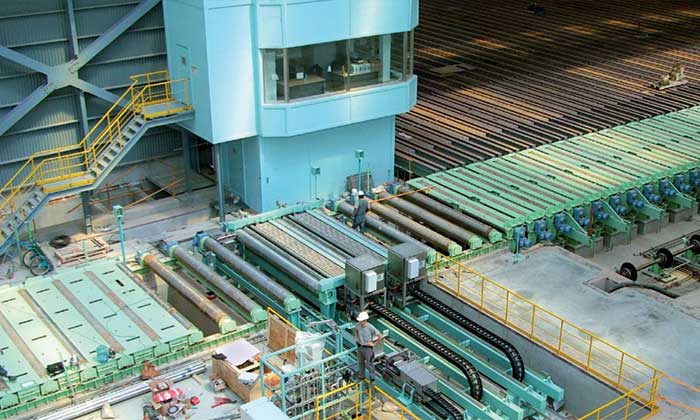
Innovative testing meets customer-specific solution
Steel and rolling mills are faced with increasingly tough quality requirements, which require verification through testing processes that are compliant with international standards or individual agreements. FOERSTER’s DEFECTOPLATE test system is particularly suitable for verifying and assessing laminar discontinuities in heavy and thick plate with ultrasound.
The system features a modular concept, allowing tried-and-tested components to be adjusted to meet local requirements so as to generate the greatest possible functionality and process reliability. Depending on the production layout and requirements, various concepts can be applied to install the test systems either above the roller conveyor (test from the top) or integrated them in the latter (test from the bottom). Depending on concept, the entire plate is tested in one run or by testing in lines across the entire surface of the upright plate.
The raw data of laminar discontinuities in the material is recorded via ultrasound, pre-processed by the test electronics, and transmitted to the analysis software for assessment. The system also facilitates fully automatic assessments in accordance with various international standards and test standards defined by the system operator. If a plate does not meet quality requirements, repeated analyses can be performed in accordance with other standards on the basis of the stored test data without having to re-test the plate, which removes the need for handling the plate again.
Your advantages at a glance
- Automatic data storage for proving laminar discontinuities in the material across the entire width of the plate in one test run
- High testing capacity of approx. 720 plates per day
- Automatic and reproducible test documentation compliant with international and individually defined standards can be prepared thanks to the analysis software
- Optional subsequent offline analyses based on various test standards can be performed with the analysis software. As a result, repeated inspection runs are no longer required and operation is simplified
- Tested materials can be used to access premium markets and increase sales
- Less production resources are required thanks to the use of the test system as process monitoring and optimization tool
Technical Data
| Ultrasound electronics and equipment: | FOERSTER ultrasound electronics, FOERSTER analysis software |
| Sender / receiver test heads: | S1E1 / S1E3 / S1E4, 5 MHz |
| Test speed: | ≤ 1,000 mm/s |
| Testing distance: | 1 mm (at max. 1,000 mm/s) |
| Test sensitivity: | KSR2, KSR3 |
| Dead zones: (benchmarks, depending on reflector size and depth) |
Approx. 1.5 mm, both sides Untested edges (depending on system concept and design, deviating |
| Untested edges: (depending on system concept and design, deviating values may occur) |
▪ Longitudinal edges with test ≤ 5 mm for cut plates / ≤ 15 mm for uncut plates ▪ Transverse edge without top / bottom testing ≤ 80 mm ▪ Transverse edge with top / bottom testing ≤ 5 mm (only for cut plates) |
| Materials: | Low-alloyed ferrite steel |
| Plate dimensions: (benchmarks, deviating values in accordance with customer-specific requirements) |
Length 3,000 – 52,000 mm, width 900 – 5,400 mm, thickness 5 – 175 mm |
| Plate temperature: | Surface 5 – 120 °C, optionally up to 200 °C |
| Plate condition: | ▪ Rough rolled surface free from contamination, oil, grease, paint, as well as loose particles and scale ▪ Preferably no warping and deformed edges (indentation and burring at the cut or residue from flame cutting) ▪ Restricted maximum tilt |
Norms
JIS G 0901
Describes the ultrasound testing of steel plates for pressure tanks.
AS 1710-2007
Describes the ultrasound test method used for testing carbon and low-alloyed sheet steel and universal profiles and defines a quality classification.
ASME SA 435
Specifies the ultrasound testing of steel plates with a vertical test head.
ASME SA 578
Specifies the ultrasound testing of rolled steel plates for special applications with a vertical test head.
ASTM A 435
Comprise the standard and acceptance standards for ultrasound testing of rolled, fully deoxidized carbon steel plates and alloyed steel plates using the pulse-echo method with a vertical test head.
ASTM A 578
Comprise the standard and acceptance standards for ultrasound testing of rolled and alloyed steel plates using the pulse-echo method with a vertical test head.
BS 5996:1993
Defines the acceptance threshold for discontinuities in sheet steel, strip, and universal plate, based on ultrasound testing.
DNV OS-F 101
Contains criteria and guidelines for manufacturing, assembling, testing, commissioning, and maintaining tubing systems. A full ultrasound test of plates, strips, and tubes for laminar discontinuities is recommended and its requirements defined.
EN 10160
Describes the ultrasound testing of flat steel products with a thickness of 6 mm or above (reflection method).
EURONORM 160-85
Describes the ultrasound testing of sheet steel with a thickness of 6 mm or above (reflection method).
GB/T 2970-2004
Describes the ultrasound testing method for thick steel plate.
GOST 22727-1988
Describes ultrasound testing methods for rolled plate.
ISO 10893-9
Describes the automatic ultrasound testing of strip and plate used for the production of welded steel tubes for detecting lamination.
ISO 17577
Describes the ultrasound testing of flat steel products with a thickness of 6 mm or above.
ISO 3183
Specifies the requirements and test methods for steel tubes used for tuning system transport systems in the crude oil and natural gas sector.
JB 4730-1994
Specifies five non-destructive test and defect classification methods, such as the ultrasound testing of raw materials, replacement parts, and weld seams of metallic pressure tanks.
JIS G 0801
Describes the ultrasound testing of steel plates for pressure tanks.
NF A04-305
Describes the ultrasound testing of flat steel products with a thickness of 6 mm or above (reflection method).
